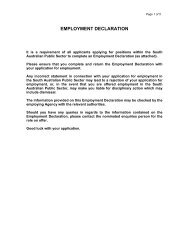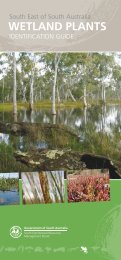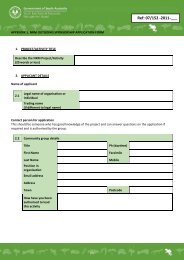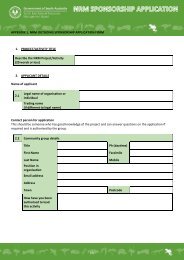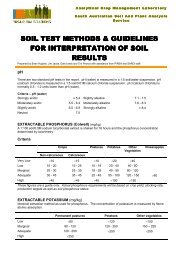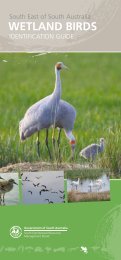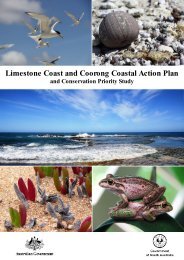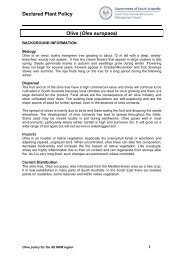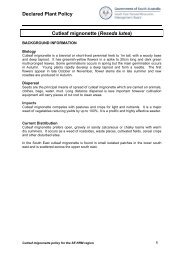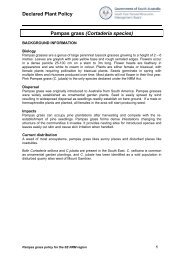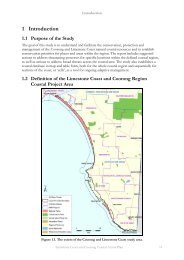Cell Descriptions - South East Natural Resources Management Board
Cell Descriptions - South East Natural Resources Management Board
Cell Descriptions - South East Natural Resources Management Board
Create successful ePaper yourself
Turn your PDF publications into a flip-book with our unique Google optimized e-Paper software.
SE3 – Cape Douglas<br />
98% of coastal dunes are vegetated with Leucopogon parviflorus, Acacia longifolia var. sophorae, Olearia<br />
axillaris tall shrubland over Lepidosperma gladiatum, Isolepsis nodosa over ground covers. Rushland/<br />
sedgeland backing dunes at mid-Umpherstone Bay has shrub Melaleuca halmatororum over Gahnia<br />
filum.<br />
205 bird species have been recorded in this cell, including the EPBC listed endangered Orangebellied<br />
Parrot (Neophema chrysogaster) and State endangered <strong>East</strong>ern Osprey (Pandion cristatus), and<br />
Little (Sternula albifrons) and Fairy (Sternula nereis) Terns. 7 butterflies, 11 mammals, 5 reptiles and 3<br />
amphibians have also been recorded.<br />
Land Use/ Land Ownership<br />
Most of this cell is privately owned; however 14.3% is Crown land, and the tiny Cape Douglas<br />
CP makes up 3% of the cell. SA Water Corporation controls 2 headland areas as wastewater<br />
treatment plant reserve at Finger Point and the next small headland to the west. A narrow<br />
unallotted Crown Land reserve exists between Cape Northumberland and Cape Douglas.<br />
Values/ Uses (Field visits and local reports)<br />
Highly utilised scenic drive between Cape Northumberland and Finger Point. Aboriginal<br />
Heritage values throughout.<br />
Threats (Field visits and local reports)<br />
McLaren et al 1980 report that domestic rubbish from Port MacDonnell was dumped into the<br />
sea at Cape Northumberland, via a metal chute, (then dispersed by wave action along the shore);<br />
however this practice ceased in the early 1980s, leaving only traces of polished glass along the<br />
shore. Excessive ORV activity between Finger Point and Cape Douglas.<br />
Opportunities<br />
Middle Point Swamp, otherwise known as Pascoe’s swamp, is an area of coastal wetland that has<br />
been drained for agricultural use. The site was partially hydrologically restored in 2005 (Taylor,<br />
2006) and is undergoing further restoration through regulation of a second drain in 2010. An<br />
action plan for the restoration of the site is being prepared by DENR.<br />
Conservation Analysis (GIS)<br />
Sum of conservation layer means is 126.29, an average total. This small cell shows good<br />
connection between intact and partially cleared dune vegetated areas; together with the coastal<br />
wetlands, these support a variety of coastal habitats for plants and animals. As a result average to<br />
good total conservation layer scores are spread across 2/3 of the cell. Small high value areas are<br />
found at Middle Point Wetland and the small wetland west of the intersection of Hut Bay Road<br />
and Thompsons Lane. The northern end of Umpherstone Bay shows notably low conservation<br />
values.<br />
High total layers for the whole cell are vegetation metrics – shape, connectivity, and size;<br />
however total number of species is not high. The Middle Point wetlands score highly for habitat<br />
of focal species Swamp skink, <strong>South</strong>ern Bell Frog and Yellow Sedge Skipper; habitat for the<br />
Orange-bellied Parrot is found extensively through the dunes and cobble ridges.<br />
The entire foreshore,



